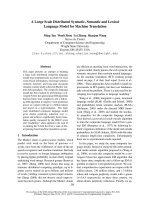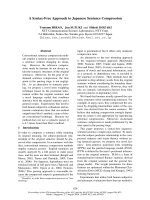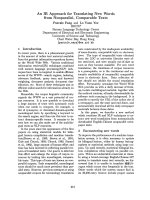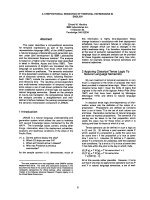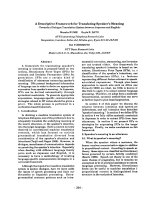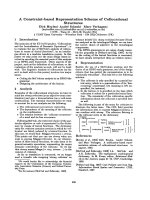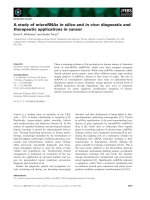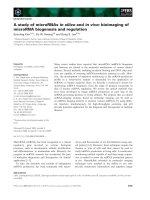Báo cáo khoa học: "A Descriptive Framework for Translating Speaker''''s Meaning Towards a Dialogue Translation System between Japanese and English" pot
Bạn đang xem bản rút gọn của tài liệu. Xem và tải ngay bản đầy đủ của tài liệu tại đây (656.66 KB, 8 trang )
A Descriptive Framework for Translating Speaker's Meaning
-
Towards a Dialogue Translation System between Japanese and English -
Masako KUME Gayle K. SATO
ATR Interpreting Telephony Research Labs
Sanpeidani, Inuidani, Seika-chd, Sdraku-gun, K yoto 619-02 JAPAN
Kei YOSHIMOTO
NTT Basic Research Labs
Midori-chd 3-9-11, Musashino-shi, Tokyo 180, JAPAN
Abstract
A framework for translating speaker's
meaning or intention is proposed based on two
notions, Illocutionary Force Types (IFTs) for
analysis and Decision Parameters (DPs) for
generation. IFTs are a certain kind of
classification of utterances concerning speaker's
meaning. DPs present background information
of language use in order to derive an appropriate
expression from speaker's meaning. In Japanese,
IFTs can be derived automatically through
syntactical constraints. To generate appropriate
expressions, language-specific communication
strategies related to DP values should be given a
priori. The whole process is performed in a
unification-based framework.
1. Introduction
In devising a machine translation system of
telephone dialogues, one of the problems is how to
adequately translate tile underlying meaning of
the source utterance, or the speaker's intention,
into the target language. Such a concern is rarely
observed in conventional machine translation
research, which has focused on strictly
grammatical translation divorced from
consideration of the speaker's situation and
intentions (Tsujii and Nagao 1988). However, in
dialogue, smoothness of communication depends
on perceiving the speaker's intention. Especially
when dealing with different language family
pairs such as Japanese and English, it is
necessary to have a methodology of treating
language-specific communication strategies in a
universal framework.
Although the input of our machine translation
system is spoken dialogue, here we leave aside
the issues of speech processing and limit our
discussion to linguistic processing. Extra-
grammatical sentence patterns such as intra-
sentential correction, stammering, and inversion
are not treated either. Our framework for
translating speaker's intention is based on two
notions, Illoeutionary Force Types (IFTs), i.e. a
classification of the speaker's intentions, and
Decision Parameters (DPs), i.e. features
representing different factors relevant to speech-
act-related expressions. Though plan-based
approaches to speech acts such as Allen and
Perrault (1980) are ideal, too little is known in
this field to apply it to actual natural language
processing. Therefore, we adopt here a moderate,
intrascntential, syntactic method that can serve
as further input to plan-based approaches.
In section 2 of this paper we discuss the
relation between intention and speech-act
indirectness, and call intention thus described
"speaker's meaning." In section 3 we define IFTs.
In section 4 we fully utilize syntactic constraints
in Japanese in order to extract II~rs from input
utterances. In section 5 we present DPs as
strategies for expressing IFTs in the target
language. Finally, we make conclusions on this
framework.
2. Speaker's meaning in an utterance
2.1. What Is speaker's meaning?
When the speaker utters a sentence, the
hearer receives communicative signs in addition
to propositional content. According to speech act
theory, these signs are classified as illocutionary
forces governed by certain felicity conditions
(Searle 1969). Speech act theory is one of the
main themes of pragmatics, but it remains too
conceptual to be of practical assistance to natural
language processing. However, illocutionary
forces can be useful to machine translation if
propositional content is distinguished from
structure in the analysis of intention.
- 264-
We begin by noting that intentions and
surface expressions have multiple
correspondences. As the following example
shows, a single surface expression can convey
several intentions:
(2-1)
gakusei waribiki wa nai no desy6 ks?
student discount TOP exist-NOT EXPL-POL QUEST
Isn't there a student discount?
ll!
REQUESTING
COMPLAINING
ADVISING
CONFIRMING
etc.
Conversely, the same intention can be conveyed
through various surface expressions, as in the
following variations of (2-1):
REQUESTING
Ill
(2-2)
gakusei waribiki o site kudasai.
student discount OBJ make do-GIVFAV-POL-IMP
Please make me a student discount.
(2-3)
gakusei waribiki o site itadaki tai
student discount OBJ make do-RECFAV-PO|, want
nodesu ga.
EXI'I,-I'OL MODEl{
1 wonder ifyou could make me a student discount.
(2-4)
watasi wa gakusei na no desu ga.
!
TOP student COPL EXPL-POL MODER
I am a student, you know.
N.B. Concerning a 'discount' request, (2-2) seems a bit
strong for a real situation although there is no specific
contexttml condition to decide definitely if it is or not. (2-1)
(2-3) and (2-4) are seen in our data.
These examples clearly show that intention is
context-dependent, and that to understand the
speaker's meaning correctly, an inference
mechanism is necessary.
Various surface expression patterns give clues
for ascertaining illocutionary forces (Wierzbicka
1986).
(2-5)
t~rokuydsi o o-okuri negae masu ks?
registration form OBJ send-POL desire POL QUEST
Can you please send me a registration form7
(2-6)
Could you kindly send them all together?
Hegau
in (2-5), a verb for request, and
ks,
the
sentence-final particle of questions, indicate
request.
Kindly
in (2-6) signals a request in
English. In other words, even without knowledge
of the context of an utterance, knowledge of
communicstive strategies of language and their
expression patterns allow the derivation of
intentions from utterances.
In the above examples, we can see there are
various ways of expressing requests. This
indirectness derives from social patterns in
requesting things common to all cultures to some
degree. On the other hand, however, it depends
on each specific society. In this paper we accept
indirectness as an unavoidable and basic feature
of spoken utterances, and deal with indirect
patterns such in (2-1) and (2-3) that will be called
speech-act indirectness.
Indirect expressions such
as (2-4), which are called
propositional
indirectness,
are not treated for the reason given
in the next subsection. We use the term
speaker's
meaning
to refer to intention expressed by
speech-act indirectness. Using this notion, we try
to capture syntactically the major portion of
speech-act-related expressions in spoken
Japanese.
2.2. Translation of speaker's meaning
We assume that for machine translation it is
sufficient to understand utterances on the level of
speech-act indirectness, without referring to
propositional indirectness. On the one hand,
when there is a large degree of indirectness such
as the omission of propositional content in (2-4)
where the topic "discount fee for students" is not
actually mentioned, we must be content with a
direct translation of what has been stated. This is
because a sentence-based translation cannot
compensate for the missing content. In addition,
since the hearer will no doubt be able to infer
something about the omitted content anyway, the
speaker is best served by a direct translation
closest to the original. On the other hand, when
the propositional content is explicitly phrased but
requires indirectness to make an appropriate
translation into the target language, a system
that concentrates on speech-act indirectness will
again be tile most useful, because socio-linguistic
differences will be expressed typically in speech-
act indirectness as in (2-1) and (2-3).
Consequently, we develop a framework aimed at
extracting speaker's meaning in terms of speech-
act indirectness.
3. I FTs
3.1.Classiflcatlon of IFTs
An experiment has been carried out on
collected data of spoken-style inter-terminal
dialogues to extract illocutionary acts. The
subject of the conversations was limited to
- 265 -
application for an international conference, and
the content was mainly on inquiry, request, and
confirmation about the conference between a
secretary and an applicant.
We classify surface IFTs into six types (Table
1). This is the immediate result of the analysis
made intrasententially by means of Head-Driven
Phrase Structure Grammar (HPSG)/Japanese
Phrase Structure Grammar (JPSG). The six
types are differentiated from each other only by
means of the uppermost predicate value that is
the result of the surface-based analysis. For
example, an indirect request with an inter-
rogative sentence pattern such as
(2-5)
t6rokuySsi o o-okuri negae masu ha?
Could you please send me a registration form?
is classified simply as an INTERROGATIVE
type, though it is OPTATIVE at the deep IFT
level. Also, a sentence with an active, present-
tense verb such as
(3-1)
tdrohuyOsi o o-ohuri si masu
registration
form
OBJ send-POL do-POL
I will send you a registration form.
is analyzed as INFORMATIVE, though it is
PROMISE at the deep level.
Table 1. SurfacelFTs
surface
surface IFT instances
predicate value
F,X PRESS! VI~ arlgat6 (thanks) arlgal6-
sumimasen (sorry) THANKS, etc.
mosimosi (hello) mosimosi-
I'liN['lC
say, nora (goodbye) ltELLO, etc.
negau (wish) x-REQU EST
OPTATIVE kudasai (please)
QUESTIONIF
I NTI~RI~,OGATI VE
ha, ne
QUESTIONREF
tai
(want)
SU
BJ
ECTIVE hosii (want to) x-WISH
INFORMATIVR
various S-INFORM
3.2.Unification-based analysis
Figure 1 diagrams an overview of the
procedure for translating speaker's meaning. In
contrast to a conventional machine translation
procedure, speaker's meaning can be analyzed
and generated, without passing through transfer,
by means of IFTs and DPs. Here, we do not
pursue machine translation problems concerning
propositional content. The processing of
speaker's meaning consists of two stages,
unification-based syntactico-semantic analysis
and plan inference. We will now give a more
precise description of these two stages.
INPUT
1
analysis l
I I
t. .J
extraction
of IFTs
r "!
I !
.j transfer ,I-
t
.I
>
OUTPUT
l
r l
-~igenerationi
t. J
forms based
on DPs
Figure 1. Speaker's meaning translation procedure
As a grammar for surface-level analysis, we
have adopted HPSG (Pollard and Sag 1987) and
JSPG (Gunji 1987), that is a modification of the
former for dealing with Japanese. On the basis of
a unification parser developed at ATR (Kogure
et
al.
1988), the grammar has been written and
proven capable of analyzing all fundamental
sentence patterns in spoken-style Japanese
conversation (Yoshimoto, Kogure and Iida 1989).
This grammar analyzes sentence (3-2) as (3-3)
by means of syntactic rules and lexical
descriptions, of which only those for the
subsidiary verb
morau
are given as (3-4).
(3-2)
t6rokuy~si o Okutte morse rnasu ka?
registration form OBJ send RECFAV-POSS POL QUEST
(lit.)
Could I have the favor of your sending me a
registration form?
(3-3)
[[SEM [[RELN QUESTIONIF]
[AGEN ?SP]
[RECP ?HR]
[OBOE [[RELN RARERU-POSSIBLE]
[OBOE [ [MORAU- RECEIVE- FAVOR[
[AGEN zxI]
[ORIG ?X2]
[OBOE [[RELN OKURU-|]
[AGEN ?X2]
[RECP ?Xl]
[oBoe TOROKUY~)SI ' ]]]]]] ]]]
[SLASH {[[HEAD [[POS P][FORN GA][GRF SUBJ]]]
[SUBCAT {}]
[SeN ~xl]]
[[HEAD [[POS P][FORM NI][GRF OBJ2]]]
[SUBCAT [}]
[SEN ?X2]])]
[PRAG ([[SPEAKER ?SP]
[HEARER ?HR]
[RESTR$ {[[RELN EMPATHY-DEGREE[
[STAM ZSP]
[MORE ?Xl]
[LESS TX2]]
[[RELN POLITE]
[AGEN ?SP]
[OBOE ?HR]]}]]}]]
- 266 -
(3-4)
(DEFLEX more V ()
[[.EAD [[POS V]
[[TYPE CONS-UV]
[croRM STEM]
[MODL [[DONT BEND]]]]]
[SUB[AT {[[HEAD [[POS P[
[FORM GA]
[GRF SUBJ]]]
[SUB[AT ()]
[SEM ?XJ]]
[[HEAD [[POS P[
[FORM NIl
[GRF OBJ2]]]
[SUB[AT {}]
[SEM ?X2]]
[[HEAD [[POS V[
[[FORM TE]
[MODL [IDEA[ PASS[[ASP[ PROG]
[PONT BENO]] IOPTT-]]]
[SUB[AT {[[HEAD [[POS P]
[FORM GA]
[GRF SUBO]]]
[SUBCAT {]]
[SEM ?X2]]}]
[SEM ?SEMI[)[
[SEM [[RELN MORAU-RECEIVE-FAVOR]
[AGEN ?Xl]
[RECP ?X2]
[OBOE ?SEMI[[
[PRAG [[SPEAKER ?SPEAKER]
[HEARER ?HEARER]
[RESTRS ([[RELN EMPATHY-DEGREE[
[STAN ?SPEAKER]
[MORE
?Xl]
[LESS ?XZ]]}]]]])
'?' is a prefix for a tag name representing a
token identity of feature structures. In (3-4), the
third member of the SUBCAT value specifies the
conjugational form and modality type of the
complement verb. The feature MODL imposes
conditions on the modality type that plays a key
role in Japanese syntax by dominating mutual
predicate component subcategorization and
subordination. In order to handle the unordered-
hess of Japanese case phrases, the SUB[AT
value is a set, following JPSG, instead of an
ordered list in the HPSG for English. The set is
expanded by a rule reader into its corresponding
possible ordered list descriptions. Since Japanese
case phrases are always postposed by a case-
indicator, they are assigned to the part-of-speech
category P. The PRAG feature stipulates here
that the speaker empathizes more with the
subject (?X1 in (3-4)) than with the indirect object
(?X2).
This pragmatic information is further utilized
with a discourse model to identify omitted
subjects and objects, because they are mostly
omitted in honorific or empathy-related
sentences.
4. Identification of IFTs
The surface analysis result such as (3-3)
serves as an input to plan schemata called IFT-
Schemata that identify deep IFTs (or merely
IFTs) syntactically by means of predicate-
internal collocation, adjunction, tense, and modal
information. An IFT-Schema consists of a goal
whose value is a partial description of a deep IFT,
and a decomposition whose value is a disjunction
of partial descriptions of surface IFTs,
preconditions, and effects as in (4-1), (4-2) and (4-
3). A surface IFT is searched for which unifies
with one of the descriptions in the decompostion.
The goal in the same schema is the resulting deep
IFT. Adoption of the unification method enables
hi-directional flow of information between the
deep speech act type and the decomposition. This
leads to an easier disambiguation and
supplementation of surface analysis results by
linguistically specifying IFTs (Kogure et el.
1988).
The difference between surface analyses and
deep IFTs is absorbed by a "thesaurus", as in (4-
4), that relates the two. This specifies that
MORAU-RECEIVE-FAVOR is a subtype of
RECEIVE-FAVOR. (4-5) is the result of the IFT
inference.
(4-1)
(DEF-IFT-SCHEMA ?REQ[[RELN REQUEST]
[AGEN
?sp]
[~ECP ?HR]
[OBOE ?OBJCCAGEN ?XB]]]
[MANN INDIRECTLY]
[ATTD INTERROGATIVELY]]
: DECOMPOSI T ION
(;MORAE MASE N KA, [TADAKE MASE N KA
[[RELN QUESTION[ F[
[AGEN ?HR]
[RECP ?sp]
[OBOE [[RELN NEGATION[
[TENSE PRESENT]
[OBOE [[RELN POSSIBLE]
[AGEN ?SP]
lOBaR [[RELN RECEZVE-FAVOR]
[AGEN ?SP]
[SOUR
THe[
[OBOE ?OBO]]]]]]]]
, )
;NEGAE MASU KA
[[RELN QUESTION[F[
[AGEN ?HR]
[RECP ?SP]
[OBJE [[RELN POSSIBLE]
[TENSE PRESENT]
[AGEN
?SP]
[OBOE [[RELN REQUEST]
[AGEN ?SP]
[RECP ?HR]
[OBOE ?OBJ]]]]]]
- 267-
(4-2)
(DEF-IFT-SCHEMA ?REQ[GRELN REQUEST]
[AGEN ?SP]
[RECP ?HR]
[OBOE ?OBJ[[AGEN ?He]]]
[MANN INDIRECTLY]
[ATTD DECLARATIVELY]]
:DECOMPOSITIONS
(;MORAI TAI NO DESU GA,
;ITADAKI TAI NO DESU GA
[[RELN S-INFORM]
[OBOE [GREEN MODERATE]
[OBOE [[RELN DESIRE]
[TENSE PRESENT]
[EXPN ?SP]
[OBOE [[RELN RECEIVE-FAVOR]
[AGEN ?SP]
[SOUR ?HR]
[OBOE ?OBJ]]]]]]]]
• )
)
(4-3)
(DEF-IFT-SCHEMA ?REQGGRELN REQUEST]
[AGEN ?SP]
[RECP ?HR]
[OBOE ?OBO[GAGEN ?HR]]]
[MANN DIRECTLY]
[ATTO DECLARATIVELY]]
:DECOMPOSITIONS
(;KURE, KUDASAI
[[flELN REQUEST]
[AGEN ?SP]
[SOUR
~He]
[OBJE ?OBOE]
• )
)
(4-4)
(RELATION-IS-A MORAU-RECEIVE-FAVOR RECEIVE-FAVOR)
(REEATION-IS-A ITADAKU-RECEIVE-FAVOR RECEIVE-FAVOR)
(RELAIION-IS-A KA-QUESTIONIF INFORMIF)
(EELATION-IS-A NARERU-POSSIBLE POSSIBLE)
(RELATION-IS-A DEKIRU-POSSIBLE POSSIBLE)
By this mechanism, the IFT of sentence
(3-2)
is inferred as (4-5).
(4-5)
[GRELN REQUEST]
GAGEN ?sp]
GRECP ?HR]
[OBOE [GREEN OKURU-I]
GAGEN ?HR]
[flECP ?SP]
[OBOE TOROKUYOSI']
[MANN INDIRECTLY]
[AITD INTERROGATIVELY]]
In identifying deep IFTs, syntactic constraints
in Japanese are fully utulized.
On the one hand, IFTs SUBJECTIVE and
OPTATIVE are universally limited to
expressions with first person singular subject and
present tense and without modal information,
and Japanese surface predicates reflect these
restrictions very well. Also, OPTATIVE is
limited to second person recipient. For example,
(4-6) ¢SBJ kaigi ni mdsikomi tai.
conference OBJ2 reserve want
I would like to register for the conference.
(4-7) ~SBJ
kaigi ni mdsikomi tai sd do.
conferenceOBJ2 reserve want l-hear
I hear (someone) wants to register for the conference.
While sentence (4-6) with the present, non-modal
auxiliary tai (want to) belongs to the
SUBJECTIVE type, (4-7) with the evidential
modality belongs to the ASSER'ITVE type. This
fact is utilized, by means of two lexical
descriptions of tai and IFT-Schemata restricting
the decomposition members' person, tense, and
modal information, to identify the omitted subject
of(4-6) as the first person, and that of(4-7) as the
third person.
On the other hand, adverbials that exclusively
modify deep IFTs are also utilized in
disambiguating IFTs, For example, a sentence
with O-Regal simasu (request, implore) is
ambiguous among OPTATIVE, ASSERTIVE,
and PROMISE. If it is modified by dEzo (please),
however, the sentence is always an OPI'ATIVE
type.
Deep IFTs with their corresponding syntactic
constraints are diagramed by Table 2. Instances
in the Table indicate each of the corresponding
deep IFTs, but the opposite is not necessarily
true. For example, a deep IFT OPTATIVE can be
indicated by complex predicates that belong to
the surface category INTERROGATIVE or
ASSERTIVE. Table 3 illustrates the relation
between the deep IFT OPTATIVE and its
corresponding surface IFT with instances.
Table 2. Deep IFTs and Constraints (Part)
surface IFT syntactic
constraints adjuncts
EXPRESSIVE
d~mo
1st pers., sing. sbj.
dEzo, dEha,
OPTAT! VE 2nd person obj2
sumimaseen
present, non-modal
(go)
ittai,
INTERROGATIVE
somosomo
SUBJECTIVE
zehi
IsL pers., sing. sb.i.
; present, non-modal
- 268 -
Table 3. Surface Expressions for Deep OPTATIVE
surface IFT
OPTATIVE
INTERROGATIVF~
SUBJECTIVE
ASSERTIVE
instances with literal
translation
te hosii n desu ga
(I would like you to )
o-negai si masu
(I request you to )
re hure masu ha?
(will you do me the favor of )
re kure masen ks?
(won't you do me the favor of ?)
te morae masu ha?
(can I receive the favor of ?)
tain desu ga
(I would like to )
re morai tain desu ga
(I 'd like to receive the favor of )
re morai masu
(I will receive the favor of )
to arigatai n desu ga
(I would be happy if you )
By so specifying the IFT, information absent
in surface utterances such as zero anaphora are
compensated for and in some cases multiple
analyses are disambiguated. (3-3), the surface
analysis of (3-2), is analyzed as (4-5). This
enables an adequate English translation
(4-8)
instead of an inappropriate literal translation (4-
9). Note that at the same time the subject and
indirect object missing in the surface sentence are
compensated for by the IFT specification of the
agent and recipient.
(4-8) Could you send me a registration form?
(4-9) *Can I receive a favor of your sending me a
registration form?
5.
Dl's
5.1. Necessity of DPs
We can summarize the difference between
Japanese and English communication behavior
as follows:
Japanese interpersonal relation is the most
essential factor
English interpersonal relation is
essential, but how to convey or
read intentions is more
important
For example, (5-1) is an utterance from a boss to a
secretary to request him to work overtime. This
Japanese utterance is not an order because it is
expressed in a polite way using the negative
interrogative. This kind of request is not unusual
in Japanese because of the priority given to social
standing. Because Japanese think a request
phrased like this is normal, the English
translation shown in (5-1) using can and sorry
seems appropriate to them, too. But actually an
appropriate translation requires a more polite
expression that addresses the secretary's
inconvenience, as in (5-1)'. Thus, to get an
appropriate translation of (5-1), we must
reconsider from the viewpoint of the target
language interpersonal relations between the
speaker and the hearer and the inconvenience of
requested action for the hearer.
(5-1) sumanaiga, zangyd site syorui o
sorry work overtime documentsOBJ
taipu site kure nai ha na?
type do-GIVFEV NEG QUEST
Sorry, but can you stay late to type these documents?
(5-1)' Do you think you could possibly stay late
to type these documents?
To resolve these communicative differences
between Japanese and English, we assume four
kinds of parameterlzed factors, which we call
Decision Parameters (DPs). These are:
interpersonal relation, cost-benefit relation,
definiteness of propositional content, and
topicality of propositional content. Interpersonal
relation indicates the situational relationship
between utterance participants as constituted by
age, social status, familiarity, gender, and the
other factors governing use of Japanese
honorifics. Cost-benefit relation indicates
whether the action intended by the speaker's
utterance is convenient to the speaker or to the
hearer. Definiteness of propositional content
means whether propositional content is routine
or easily performed work, or whether it requires
additional or unusual work. Topicality of
propositional content is related to the position of
an utterance in discourse, which means whether
or not the speaker's intention is already implied.
Table 4 shows these four parameters and their
values. In particular, DP4 or topicality presents
discourse information which affects the
politeness level of surface expressions. In the
present experimental situation, extraction of
speaker's meaning is limited to isolated
utterances separate from discourse structure, but
- 269 -
to get appropriate expressions in generation, we
need DP4 in connection with a discourse model.
Table 4. DPs and values
DPs
1 interpersonal
relation
Values
authority in HR /
a. inSP / EQual
2 cost-benefit convenient for HR /
relation c. forSP / NoMarK
3 definiteness of ROUtine I UNuSual
propositional content
4 topicality of + I
propositional content
5.2. Selection of surface IFT by referring to
I)P values
In the plan inference method of generation, we
use DPs in order to get appropriate English
surface IFTs to convey IFTs in English. Since we
are limiting the input to a task-oriented domain
like conferences, we can re-state input in terms
of propositional content. This propositional
content is then measured in terms of the three DP
values as a default (Table 5).
Table
5.
Default values of DPs
Propositional Content DP1 DP2 DP3
[A] Request
(from a client to a secretary)*
(1) send a registration form HR SP ROU
(2) inform about the conference HR SP ROU
(3) assist a hotel accomodation HR SP ROU
(4) provide an interpreter HR SP UNS
(5) give a student discount HR SP UNS
(6) reimburse a fee HR SP UNS
(7) come for to the station HR SP U NS
[S] Request
(from a secretariy to a client)
(8) send back the registration form HR SP ROU
(9) tell one's name and address HR SP ROU
(10) make a registration procedure HR SP ROU
(11) pay by bank transfer HR SP UNS
(12) take part in the party HR SP UNS
(13) be informed about persons HR SP UNS
who wish to participate
*In bt, siness telephone conversations in English, the
hearer is always considered to be in a higher position,
even in the case of a boss to a secretary. So the value of
DP1 for [A] is always IlR.
We suppose that differences between Japanese
and English consist in the different amount of
DPs we should refer to when extracting surface
IFTs. Japanese surface IFTs will be concerned
with DP1 and DP2 since Japanese expressions do
not stress speaker's intention, whereas English
surface IFTs will range over all four DPs and
produce a larger range of appropriate translation
choices.
For example, (1) and (7) ofTable 5 which differ
in definiteness of propositional content (i.e.
routine or unusual), can be generated in the same
way in Japanese, which involves only DP1 and
DP2. That is,
(5-2)
t6rokuydsi o okut-te moral tai
registration form OBJ send do-RBCFAV want
no desu ga.
(1)
EXPL-POL MODER
(5-3)
eki made mukaeni hi-re moral tai
station LOC come for do-RECFAV want
no desu ga.
(7)
EXPL-POL MODER
In English, however, these propositional contents
will be generated in different expressions. In case
(7), to convey the unusual but really necessary
'picking up' request, an adequate expression
requires more politeness.
(5-2)'
Could you sehd me a registration form
please?
(1)
(5-3)' Ca)
I was wondering ifl could have someone
pick me up at the station.
(7)
(b)
Would it be possible for someone to pick
me up at the station, please?
(7)
With reference to discourse information, DP4,
the appropiate English surface IFT will be graded
up or down depending on its position in the
discourse. The mapping from Japanese surface
IFT to English surface IFT is schematized as in
Table 6. We can categorize English request
expressions into two kinds. One is direct
expressions with
please,
which we call PLEASE,
and others are expressions containing several
levels of politeness such as
could you ?, is it
possible to ?, I am wondering,
etc., which we call
PLEASE-PLUS. Japanese surface IFTs are
separated into two types, INTERROGATIVE and
others,
i.e.
declarative requests using
OPTATIVE, SUBJECTIVE or ASSERTIVE type.
When a Japanese surface IFT is
INTERROGATIVE as in (5-4) and (5-5), and if
the IFT is already implied in preceding
utterances, the English surface IFT can be
- 270-
expressed simply with PLEASE type as in (5-4)'
and (5-5)', otherwise it should be expressed in
PLEASE-PLUS type such as several kinds of
English speech-act indirectness as in (5-4)" and
(5-5)". On the other hand, when the Japanese
surface IFT is others such as OPTATIVE or
SUBJECTIVE as in (5-2) and (5-3), and if IFT is
already implied in preceding utterances, the
English surface IFT should be expressed in
PLEASE-PLUS as in (5-2)" and (5-3)".
Table 6. Mapping relation concerning
DP4
J. surface IFT DP4 E. surface IFT
+ PLEASE
INTERROGATIVE
Others
-I-
PLEASE-PLUS
PLEASE-PLUS
PLEASE
(5-4) t~rokuy6si o okut-te morse masu ka?(1)
registration form OBJ senddo-RECFAV POL QUEST
(5-4)' . so please send me a registration form.
(5-4)" Hello, is it possible to send me a registration
form?
(5-5) eki made mukae ni ki-te morse masu ha?(7)
station LOC comet or do-RECFAV POL QUEST
(5-5)' , then please pich me up at the station.
(5-5)" I am calling you because I was wondering if
you could possibly send someone to pick me
up at the station.
(5-2) t6rokuy6si o okut-te moral tai
reglstrationform OBJ send do-RECFAV want
no desu ga. (1)
EXPL-POL MODER
(5-2)" then, I would appreciate it if you could
send me a registration form.
(5-3) eki made mukaeni ki-te moral tai
station LOC eomefor do-RECFAV want
no desu go. (7)
EXPL-POL MODER
(5-3)" so, may I ask if you could possibly have
someone pick me up at the station?
Thus, the politeness levels of English surface
IFTs in terms of speech-act indirectness are
appropriately generated by clarifying the
relation between English surface IFTs and DPs.
6. Conclusion
We proposed in this paper a descriptive
framework for translating speaker's meaning in a
dialogue translation system. This framework is
based on two notions, Illocutionary Force types
and Decision Parameters, and is aimed at
extracting speaker's meaning in terms of speech-
act indirectness since we believe that
propositional and speech-act indirectness must
both be processed separately.
Acknowledgments
The authors are grateful to Dr. Kurematsu,
the president of ATR Interpreting Telephony
Research Labs, Dr. Aizawa, the head of the
Linguistic Processing Department, and all the
members of the Linguistic Processing
Department for their constant help and
encouragement.
References
Allen, James and Raymond Perrault, 1980, "Analyzing
Intention in Utterances." Artificial Intelligence 15, 143-78.
Gunji, Takao, 1987, Japanese Phrase Structure Grammar.
Reidel.
Kogure, Kiyoshi et al., 1988, "A method of analysing
Japanese speech act types", Proc. of 2nd Itl. Conf. on
Theoretical and Methodological Issues in Machine
Translation of NaturalLanguages.
Maeda, Hiroyuki, et al. 1988, "Parsing Japanese honorifics
in unlfication-based grammar." Proc. of the 26th Annual
Meeting of the Association of Computational Lingulstics.
Pollard, Carl and Ivan Sag, 1987, Information-Based
8yntax and Semantics. vol. 1. CSLI Lecture Notes 13.
Sanford, D. and J Roach, 1987, "Representing and using
metacommunieation to control speakers' relationships in
natural-language dialogue", Int. J. of Man-Machine
,Studies, 28, 301-319.
Scoria, J., 1969, Speech Acts. Cambridge University Press.
Scoria, J., 1979, Expression and Meaning; Studies in the
Theory of Speech Acts. Cambridge Univ. Press.
Ts~ii, J. and M. Nagao, 1988, "Dialogue Translation vs.
Text Translation -hlterpretation Based Approach-", Proc. of
Coling 88.
Yoshimoto, Kei, 1987, "Identification br Zero Pronouns in
Japanese." The XIVth International Congress of Linguists.
Aug. 10, Berlin.
Yoshimoto, Kei, 1988, "Identifying Zero Pronouns in
Japanese Dialogue." Proc. of Coling 88.
¥oshimoto, Kei, Kiyoshl Kogure and tlitoshl lids, I989,
"llead-Driven Phrase Structure Grammar for Japanese
Dialogue Analysis." Unpublished manuscript, ATR.
Wierzbicka, A., 1986, "A semantic metalanguage for the
description and comparison of illocutlonary meaings",
Journal of Pragmatics 10, 67-107.
- 271 -

